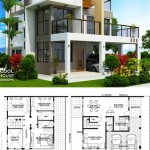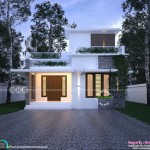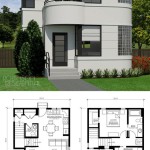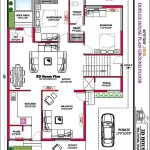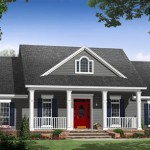1500 Sq Feet House Plan In Kerala: A Comprehensive Guide
Kerala, known for its lush landscapes and unique architectural style, presents specific considerations when planning a house. A 1500 sq ft house in Kerala offers a comfortable living space for a small to medium-sized family, balancing affordability with functionality. This article delves into the key aspects of designing a 1500 sq ft house plan tailored to the Kerala context, covering design considerations, common architectural features, material selection, and cost estimation.
Designing a house plan is a multifaceted process that requires a strategic approach. Several factors must be considered before finalizing the design, ranging from the family's specific needs to the plot's characteristics and local building regulations. In Kerala, the climate plays a significant role, influencing design choices such as roof style, ventilation, and material selection.
Effective space utilization is crucial in a 1500 sq ft house. Careful planning can maximize the available area, ensuring comfort and functionality without sacrificing aesthetic appeal. The layout should incorporate distinct zones for living, dining, sleeping, and utilities, each designed to optimize usability. Proper planning will make living in such a house enjoyable for years to come.
Key Considerations in Kerala House Plan Design
Several factors are paramount when designing a house plan in Kerala, each contributing to the overall functionality and comfort of the living space. These include site analysis, climate responsiveness, and adherence to local building regulations.
Site Analysis: A thorough site analysis is the first step. Understanding the plot's orientation, topography, soil type, and surrounding environment is crucial. The orientation influences sunlight exposure and natural ventilation. The topography dictates the foundation design and potential landscaping options. Soil type affects the building's structural integrity, necessitating specific foundation techniques. The surrounding environment, including existing vegetation and neighboring structures, needs consideration to integrate the house aesthetically and minimize disruption.
Climate Responsiveness: Kerala’s tropical climate, characterized by high humidity and heavy rainfall, requires a design that prioritizes natural ventilation and rain protection. Traditional Kerala architecture incorporates sloping roofs with wide eaves to effectively shed rainwater and protect walls from sun exposure. Cross-ventilation is crucial to dissipate heat and maintain a comfortable indoor environment. Windows and ventilators should be strategically placed to maximize airflow and reduce the need for air conditioning.
Adherence to Local Building Regulations: Kerala has specific building rules and regulations that govern aspects such as setback distances, floor area ratio (FAR), and permitted construction types. Compliance with the Kerala Municipality Building Rules (KMBR) is mandatory to obtain necessary approvals and avoid legal complications. These regulations ensure organized urban development and safety standards. Consulting with a qualified architect or engineer familiar with KMBR is essential to ensure compliance.
Typical Architectural Features in Kerala House Plans
Kerala architecture is characterized by several distinctive features that are well-suited to the local climate and cultural context. Incorporating these features into a 1500 sq ft house plan can enhance its aesthetic appeal and functional performance.
Sloping Roofs: Arguably the most recognizable feature of Kerala architecture, sloping roofs are designed to quickly shed rainwater and prevent waterlogging. These roofs are typically constructed using clay tiles or roofing sheets. The slope angle varies, but a steeper slope is generally preferred for areas with heavy rainfall. Wide eaves, extending beyond the walls, provide additional protection from sun and rain.
Courtyards (Nalukettu): While a full-fledged Nalukettu might be impractical in a 1500 sq ft house, incorporating a smaller courtyard-like space can enhance natural light and ventilation. A small open-to-sky area within the house allows for better airflow and creates a connection with nature. This space can be used as a small garden, a seating area, or a lightwell.
Verandahs (Poomukham): Verandahs, or covered porches, are traditionally used as welcoming spaces and offer protection from the elements. In a modern Kerala house plan, a smaller version of the Poomukham can serve as an entryway and provide a transition zone between the exterior and interior. It can also function as an outdoor seating area.
Natural Materials: Traditional Kerala houses often incorporate locally sourced materials such as wood, clay, and laterite stone. While modern construction may use concrete and steel for structural elements, incorporating natural materials in the facade and interior can enhance the house's aesthetic appeal and thermal performance. Wood for doors, windows, and furniture, along with clay tiles for flooring, can create a warm and inviting atmosphere. Laterite stone, known for its porous nature, can be used for creating compound walls or claddings.
Space Planning and Layout Options for a 1500 Sq Ft House
Planning the layout of a 1500 sq ft house requires careful consideration to maximize space utilization and create a comfortable living environment. Common layouts include two-bedroom and three-bedroom configurations, each with its own advantages and considerations.
Two-Bedroom Layout: A two-bedroom layout typically includes a spacious living area, a dining area, a kitchen, two bedrooms with attached bathrooms, and a work area (optional). This layout prioritizes larger living spaces and provides ample room for a small family. The bedrooms can be designed with walk-in closets or built-in storage to minimize clutter. A well-designed kitchen can include modular cabinets and efficient appliances to maximize functionality.
Three-Bedroom Layout: A three-bedroom layout provides more sleeping space, suitable for larger families or those who anticipate guests. This layout typically features a slightly smaller living area and smaller bedrooms compared to a two-bedroom configuration. Careful planning is required to ensure that each room feels comfortable and functional. The third bedroom can also serve as a home office or a guest room, depending on the family's needs. Storage solutions are crucial in a three-bedroom layout to maintain a clutter-free environment.
Open Plan Concept: Integrating an open-plan concept for the living, dining, and kitchen areas can create a sense of spaciousness and improve natural light penetration. This layout eliminates dividing walls between these areas, creating a larger, more versatile space. However, proper zoning is essential to define each area visually and functionally. Furniture arrangement, flooring materials, and lighting can be used to delineate different zones within the open plan.
Vertical Expansion: If permitted by local building regulations, consider a two-story design. This approach allows maximizing the use of the plot while maintaining a relatively smaller footprint. The ground floor can house the living area, dining area, kitchen, and one bedroom, while the upper floor can accommodate the remaining bedrooms and a family room. This layout provides more privacy and separates the living spaces from the sleeping areas.
Optimizing Natural Light and Ventilation: Regardless of the chosen layout, maximizing natural light and ventilation is crucial for creating a comfortable living environment. Windows and ventilators should be strategically placed to promote cross-ventilation and reduce the need for artificial lighting. North-facing windows allow indirect sunlight, minimizing glare and heat gain. Overhangs and shading devices can protect windows from direct sunlight during peak hours.
Sustainable Design Principles: Incorporating sustainable design principles can reduce the house's environmental impact and lower energy costs. Solar panels can generate electricity, rainwater harvesting systems can conserve water, and energy-efficient appliances can reduce energy consumption. Using locally sourced materials minimizes transportation costs and supports local industries. Proper insulation can reduce heat transfer and improve energy efficiency. Bioclimatic design, which takes into account local climate conditions, can further optimize energy performance.
Careful space planning, coupled with strategic use of natural light and ventilation, can create a 1500 sq ft house that is both comfortable and functional. Each element of the house should be carefully considered with its own place and purpose.
The key decision boils down to individual needs and preferences. It is essential to thoroughly assess the lifestyle and requirements of the family. Engage experienced professionals to realize a house plan that is efficient, meets all criteria and is suitable for the family.

അഞ ച സ ന റ ൽ 1500 Sq Ft House Plans Kerala 3 Bedroom Design Haneed Anugrahas

Two Kerala Style House Plans Under 1500 Sq Ft With Full Plan And Specifications Small Hub

13 2 Floor House Design Kerala 1500 Sq Ft Square Plans Modern

A Designer Home On 1500 Sq Ft

House Plans With Pictures 1500 Sq Ft Ranch

1500 Sqft House Plan Design Square Feet 30x50 Plans
25 Lakhs Cost Estimated 1500 Sq Ft Contemporary Home Kerala Design Bloglovin

Kerala Style Double Y House Plans Under 1600 Sq Ft For 5 Cent Plots Small Hub

1500 Sq Ft House Plan Low Cost Plans Double Story Elevations

1500 Sq Ft Modern Style Home Design

